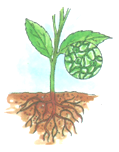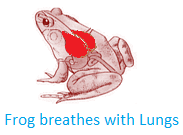Living Things Breathe
Living things breathe air to live. Practice the activity to check this on your own.
(i) We can press our nostrils between our thumb and finger now we are unable to breathe and we feel uncomfortable. When we release our thumb and finger now we can breathe easily and feel comfortable. So, we need air to breathe.
(ii) We can keep our hands in front of our nose and we can feel that air coming out of our nose at a regular interval and it shows that we breathe out. Now we can hold our breath for a few seconds with our fingers, we feel uncomfortable. As soon as we release our nose we at once start to take in deep breaths. So, it shows that we cannot live if we do not breathe in.
Similarly, like us animals and plants also breathe to live.
|
(iii) If we keep a plant in a closed box the plant will not be able to breathe and it will soon dry up and die. We might think that plants do not breathe because they do not have a nose. It is true that plants do not have noses, but they breathe through very small openings in their leaves called stomata. So, it shows that a plant also needs air to breathe. |
(iv) Like us, most of the animals breathe through their nose.
Ants, grasshoppers, cockroaches, etc. breathe through air holes in their bodies.
Thus, from the above discussion we come to know that all living things can breathe to live. Human beings, animals and plants need air to breathe.
Non-living things do not breathe. We haven’t seen a table or a chair breathing air. A table or a chair does not breathe since, they are non-living things.
Living Things Need Food and Water
Animals and PlantsFrom Living things Breathe to HOME PAGE
Recent Articles
-
Explain about Growth in Plants |Definition of Growth & Differentiation
Feb 27, 25 02:07 PM
Growth is a permanent increase in length or volume of an organism that brought upon by an increase in its dimensions due to synthesis of new protoplasmic material. -
Definition of Respiratory Quotient | calculation | Application | Plant
Dec 02, 24 12:09 AM
Definition of respiration quotient- the ratio of the carbon-dioxide evolved to that of the oxygen consumed by a cell, tissue, plants or animals in a given time is called respiratory quotient. It is us… -
Amphibolic Pathway | Definition | Examples | Pentose Phosphate Pathway
Jun 06, 24 10:40 AM
Definition of amphibolic pathway- Amphibolic pathway is a biochemical pathway where anabolism and catabolism are both combined together. Examples of amphibolic pathway- there are different biochemical… -
Respiratory Balance Sheet | TCA Cycle | ATP Consumption Process
Feb 18, 24 01:56 PM
The major component that produced during the photosynthesis is Glucose which is further metabolised by the different metabolic pathways like glycolysis, Krebs cycle, TCA cycle and produces energy whic… -
Electron Transport System and Oxidative Phosphorylation | ETC |Diagram
Feb 04, 24 01:57 PM
It is also called ETC. Electron transfer means the process where one electron relocates from one atom to the other atom. Definition of electron transport chain - The biological process where a chains…







New! Comments
Have your say about what you just read! Leave me a comment in the box below.